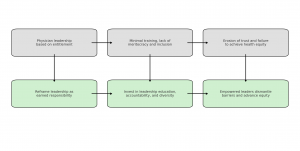Physician-Leadership Needs Reforms To Promote Healthcare Equity Or Quality; Olumuyiwa Bamgbade, Salem Pain Clinic Canada
Physician-Leaders Cannot Meet the Demands of Equitable and Performance-Based Leadership; Hence Their Need to be Trained to Promote Healthcare Equity and Quality
Most physicians receive little leadership, systems thinking, or equity training. Structured leadership education is required to equip physician-leaders with the tools necessary for modern healthcare. We must implement national mandates requiring all physician-leaders to complete competency-based training in cultural humility, health equity, data-informed decision-making, and trauma-informed leadership. This will enable physician-leaders to transcend outmoded hierarchies and function as inclusive, equity-oriented change agents by receiving leadership education rooted in lived experience, antiracism, and collaborative governance.
Without accountability, exclusionary behaviors such as ethnocentrism persist unchecked in leadership environments. Indeed, subjective partiality contributes to the homogenization of leadership teams and the silencing of diverse talent. The appointment of leaders based on seniority, likeability, or insider networks must thus be replaced by open, merit-based systems. We must establish unambiguous criteria for leadership positions, such as metrics for community engagement, peer reviews, and past performance. Additionally, we must ensure that leadership appointments are subject to inclusive external review committees. This approach will disrupt the cycles of nepotism and enable underrepresented physicians, such as women, immigrants, and minorities, to access leadership pipelines on an equal basis.
Physician-leaders must establish a vision that aligns their organizational performance with health equity objectives. We must incorporate social determinants of health, race-based data, access disparities, and patient-reported outcome measures into hospital strategic plans and quality dashboards. This will guarantee physician-leaders prioritize the closure of care disparities and resolve the underlying causes of inequity rather than merely meeting budgetary or operational objectives. Additionally, we must promote shared governance models in which physician-leaders co-lead with nurses, social workers, administrators, and community health leaders. Such approaches provide diverse lenses through which complex problems can be addressed. Furthermore, we must develop programs that pair emerging leaders with experienced, equity-minded mentors. These soft mechanisms reinforce empathy, humility, and openness, qualities often missing from traditional physician-leader archetypes.
Physician leadership must evolve from a position of entitlement to one of earned responsibility, strategic vision, and cultural humility. By investing in leadership education, meritocracy, accountability, and diversity, health systems can unlock physician-leaders' full potential to serve their teams and communities more effectively. Through equity-centered governance and inclusive mentorship, physician-leaders can evolve into the transformative figures the healthcare system urgently needs. Their credibility, visibility, and clinical insight give them a unique platform, if appropriately empowered, to dismantle systemic barriers, rebuild workforce trust, and advance health equity in measurable, lasting ways.
Dr. Bamgbade is a healthcare leader with an interest in value-based healthcare delivery. He is a specialist physician trained in Nigeria, Britain, the USA, and South Korea. He is an adjunct professor at institutions in Africa, Europe, and North America. He has collaborated with researchers in Nigeria, Australia, Rwanda, the USA, Kenya, Armenia, South Africa, Britain, Tanzania, Namibia, Iran, Zambia, Botswana, China, Ethiopia, Mozambique, Jamaica, and Canada. He has published 45 scientific papers in PubMed-indexed journals. He is the director of Salem Pain Clinic, a specialist and research clinic in Surrey, BC, Canada. Dr. Bamgbade and Salem Pain Clinic focus on researching and managing pain, health equity, injury rehabilitation, neuropathy, insomnia, public safety, substance misuse, medical sociology, public health, medicolegal science, and perioperative care.
References
Endalamaw, A., Khatri, R. B., Mengistu, T. S., Erku, D., Wolka, E., Zewdie, A., & Assefa, Y. (2024). A scoping review of continuous quality improvement in healthcare system: Conceptualization, models and tools, barriers and facilitators, and impact. BMC Health Services Research, 24, 487.
Joshi, A. (2025). Inquisition: How the System Hunts Physicians Who Refuse to Kneel. SoMeDocs (April 14).
Moineau, G. (2025). Ground-breaking new report reveals Canada can’t train enough doctors and other health professionals. Unless we dramatically change how we do things. Canadian Medical Association (January 31).
Okpala, P. (2018). Balancing quality healthcare services and costs through collaborative leadership. Journal of Healthcare Management, 63(6), e148–e157.
Rosenbaum, L. (2022). Unclouded judgment - Global health and the moral clarity of Paul Farmer. The New England Journal of Medicine, 386(15), 1470–1474.
Ruzycki S, Brown A. (2021). 'Inequity is a public health crisis': New article finds Canadian medical leadership lacking in diversity. University of Calgary (June 16).
Shanafelt, T., & Swensen, S. (2017). Leadership and Physician Burnout: Using the Annual Review to Reduce Burnout and Promote Engagement. American Journal of Medical Quality: The Official Journal of the American College of Medical Quality, 32(5), 563–565.
Spilg, E. G., McNeill, K., Dodd-Moher, M., Dobransky, J. S., Sabri, E., Maniate, J. M., & Gartke, K. A. (2025). Physician leadership and its effect on physician burnout and satisfaction during the COVID-19 pandemic. Journal of Healthcare Leadership, 17, 49–61.
Tsapnidou, E., Kelesi, M., Rovithis, M., Katharakis, G., Gerogianni, G., Dafogianni, C., Toylia, G., Fasoi, G., & Stavropoulou, A. (2024). Transformational Leadership - Quality Achievements and Benefits for the Healthcare Organizations: A Scoping Review. Hospitals, 1(1), 87–103.
Olumuyiwa Bamgbade
Salem Anaesthesia Pain Clinic
+1 778-628-6600
salem.painclinic@gmail.com
Legal Disclaimer:
EIN Presswire provides this news content "as is" without warranty of any kind. We do not accept any responsibility or liability for the accuracy, content, images, videos, licenses, completeness, legality, or reliability of the information contained in this article. If you have any complaints or copyright issues related to this article, kindly contact the author above.
BMJ Physiotherapy Expands to One@Kentridge Medical Centre Adjacent to NUH
New Book Reveals Untold Story of Royalty in America
Puraffinity and U.S. Army Corps of Engineers Partner to Advance PFAS Remediation Technologies
Kalendarium
Więcej ważnych informacji
 Jedynka Newserii
Jedynka Newserii

 Jedynka Newserii
Jedynka Newserii

Prawo

KE proponuje nowy Fundusz Konkurencyjności. Ma pobudzić inwestycje w strategiczne dla Europy technologie
W środę 16 lipca Komisja Europejska przedstawiła projekt budżetu na lata 2028–2034. Jedna z propozycji zakłada utworzenie Europejskiego Funduszu Konkurencyjności o wartości ponad 400 mld euro, który ma pobudzić inwestycje w technologie strategiczne dla jednolitego rynku. Wśród wspieranych obszarów znalazła się obronność i przestrzeń kosmiczna. Na ten cel ma trafić ponad 130 mld euro, pięciokrotnie więcej niż do tej pory.
Firma
Były prezes PGE: OZE potrzebuje wsparcia magazynów energii. To temat traktowany po macoszemu

Choć udział odnawialnych źródeł energii w miksie energetycznym Polski jest stosunkowo wysoki i rośnie, to ten przyrost jest chaotyczny i nierównomiernie rozłożony miedzy technologiami – wskazuje Forum Energii. Dodatkowo OZE potrzebują wsparcia magazynów energii, a zdaniem Wojciecha Dąbrowskiego, prezesa Fundacji SET, ten temat jest traktowany po macoszemu. Brak magazynów powoduje, że produkcja energii z OZE jest tymczasowo wyłączana, co oznacza marnowanie potencjału tych źródeł.
Infrastruktura
Wzrost wynagrodzeń ekip budowlanych najmocniej wpływa na koszty budowy domu. Zainteresowanie inwestorów mimo to nieznacznie wzrasta

Budowa metra kwadratowego domu w Polsce kosztuje od 5,55 do 6 tys. zł w zależności od województwa – wynika z najnowszych analiz firmy Sekocenbud. Najdrożej jest w Warszawie, gdzie cena za metr kwadratowy domu przekroczyła już 6,2 tys. zł. Na przyrosty kosztów budowy domu wpływają zarówno drożejące materiały budowlane, jak i wyższe wynagrodzenia pracowników. Inwestorzy nie rezygnują jednak z budowy domów jednorodzinnych, co ma związek m.in. z wciąż wysokimi cenami mieszkań czy też obniżką stóp procentowych.
Partner serwisu
Szkolenia

Akademia Newserii
Akademia Newserii to projekt, w ramach którego najlepsi polscy dziennikarze biznesowi, giełdowi oraz lifestylowi, a także szkoleniowcy z wieloletnim doświadczeniem dzielą się swoją wiedzą nt. pracy z mediami.










.gif)

 |
| |
| |
|